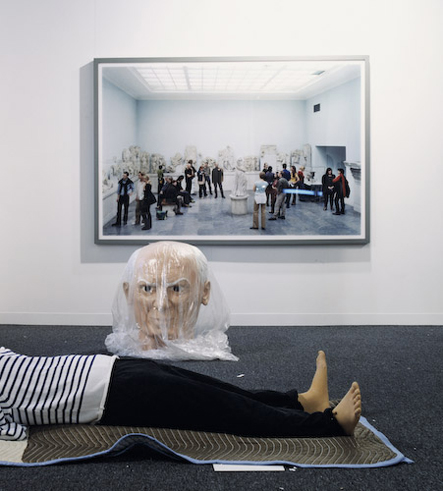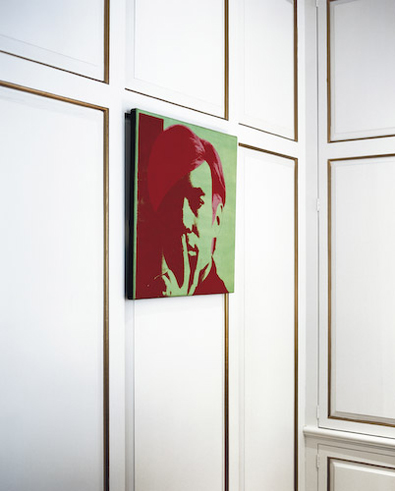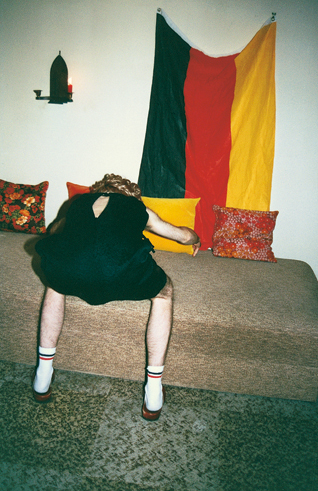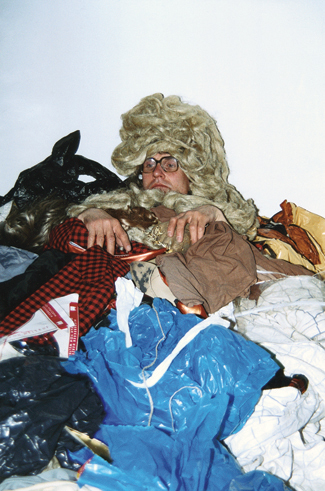Camera Austria International
92 | 2005
- ACHIM HOCHDÖRFER
Louise Lawler: Preliminary Remarks on a "Phenomenology of Cuts" - LOUISE LAWLER
- SØNKE GAU
Sofie Thorsen: Prefab Dreams - SOFIE THORSEN
- BASAK SENOVA
Osman Bozkurt: Rejection Episodes And Fragments of Memory - OSMAN BOZKURT
- BRUNO BATINIC
Laura Samaraweerová: Traces of Foreigness - LAURA SAMARAWEEROVÃ
- MANISHA JOTHADY
Michael Janiszewski: An Aesthetics of Self-Will - MICHAEL JANISZEWSKI
- CARLO MCCORMICK
The Occular Occult - Seeing Is Believing

Preface
Since the beginning of 1980, Camera Austria has devoted its attention to photography in the context of contemporary art, new media, new image technologies, and social developments. Special attention is given to current approaches that deal with the medium and the patterns of its reception against the background of overall cultural conditions. Such a general art debate is also continuously refocusing on the perspective of photography, which is why we felt this to be a good opportunity to discuss the work of an internationally established artist afresh: Louise Lawler questions her privileged position as an artist as much as she queries borderline institutional spheres. She identifies the autonomous art work as fiction, embedded as it has always been in social, historical and thematic contexts. Lawler has always been type-cast as being primarily concerned with critique of modernism and institutional critique, a fact that – according to Achim Hochdörfer’s thesis – has so far obfuscated the view of other important aspects in her work: “for example, what is the status of the individual photographs in Lawler’s work? Does she ultimately aestheticise what she aims to unmask and deconstruct as a power structure?” Hochdörfer investigates these questions among other things by analysing Lawler’s artistic practice of cropping (cutting out, cutting off and cutting away from her photos) with regard to Jacques Derrida’s comments on the parergon, the framing accessory.
Read more →Camera Austria International 92 | 2005
Preface
Since the beginning of 1980, Camera Austria has devoted its attention to photography in the context of contemporary art, new media, new image technologies, and social developments. Special attention is given to current approaches that deal with the medium and the patterns of its reception against the background of overall cultural conditions. Such a general art debate is also continuously refocusing on the perspective of photography, which is why we felt this to be a good opportunity to discuss the work of an internationally established artist afresh: Louise Lawler questions her privileged position as an artist as much as she queries borderline institutional spheres. She identifies the autonomous art work as fiction, embedded as it has always been in social, historical and thematic contexts. Lawler has always been type-cast as being primarily concerned with critique of modernism and institutional critique, a fact that – according to Achim Hochdörfer’s thesis – has so far obfuscated the view of other important aspects in her work: “for example, what is the status of the individual photographs in Lawler’s work? Does she ultimately aestheticise what she aims to unmask and deconstruct as a power structure?” Hochdörfer investigates these questions among other things by analysing Lawler’s artistic practice of cropping (cutting out, cutting off and cutting away from her photos) with regard to Jacques Derrida’s comments on the parergon, the framing accessory.
In contrast to Lawler, who never leaves the systemic contexts of art, Sofie Thorsen explores the structure and appearance of spheres outside the art industry. With the aid of changing media she investigates the change of rural forms of housing, living conditions and social structures under the influence of tourism. In so doing – according to Sønke Gau – she debunks the myth of the cosy village as a phantasm, along with the attempt to capture reality. Where the subject of Thorsen’s meticulous analysis is above all the village model, Osman Bozkurt is in contrast interested in the niches of coexistence beyond the realm of firmly established spatial and social structures. Based on the situations photographed by Bozkurt, Basak Senova develops her theory of (unconscious and fleeting) “social resistance”, subtle opposition to powerful state machinery (here: of Turkey).
Resistance features in the work of Laura Samaraweerová in the form of questioning conventional concepts of beauty and space, conventional forms of communication and social behaviour, and traditional understandings of use and sequences of action. In her staged settings, supposedly everyday observations are transformed – according to Bruno Batinic – into seemingly absurd, surreal contexts and situations.
The works of Michael Janiszewski are also invested with an air of the absurd and surreal. After publishing a first monograph of his work in Edition Camera Austria in 2000, followed by an exhibition and artist’s edition the same year, we are now presenting his works for the first time on a larger scale in our magazine. “Related to photographic picture concepts from surrealism, for Janiszewski the photo becomes a vehicle of oppressive manifestations, metamorphoses, fetishisations, scandalisations and delusions in which set pieces of everyday life enter into disorderly, paradox combinations “, writes Manisha Jothady.
As we near the end of the year, we would like to thank our subscribers, readers and advertisers for their sustained interest in our project. We hope you enjoy reading Camera Austria No. 92 and wish you happy holidays and a good 2006.
Christine Frisinghelli
Entries
Forum
KARINA NIMMERFALL
BELAID LE MHARCHI
ANNE KATHRIN GREINER
LAURENT FRIOB
LUCA FACCIO
CORINNE VIONNET
CECILIA JÄRDEMAR
AKIKO SATO
Exhibitions
Hans-Peter Feldmann und Klaus Heilmann: Frauen im Gefängnis.
Barbara Wien, Berlin
MAREN LÜBBKE-TIDOW
Eine Sammlung als diskursive Formation. Occupying Space. Sammlung Generali Foundation.
Galerie Klovicevi dvori, Zagreb
REINHARD BRAUN
Der soziographische Blick 11: Michaela Moscouw.
Kunstraum Innsbruck
Ein tschechisches Universum: Jindrich Štreit.
Fotoforum West, Innsbruck
MAREN RICHTER
After the Fact: 1. Berlin. Photography Festival 2005.
CAROLIN FÖRSTER
Gregory Crewdson 1985 – 2005.
Kunstverein Hannover
HOLGER RÖMERS
Jeremy Deller.
Kunstverein München
HANS-JÜRGEN HAFNER
Welt-Bilder.
Helmhaus, Zürich
WOLFGANG BRÜCKLE
Der tote Blick. Nützlich – süss – museal. Das Fotografierte Tier.
Museum Folkwang, Essen
KERSTIN STREMMEL
I have a picture. Coolhunters. Jugendkulturen: Zwischen Medien und Markt.
ZKM, Karlsruhe; Künstlerhaus Wien
REINHARD BRAUN
Jonathan Monk: Continuous Project Altered Daily.
ICA, London
NIELS HENRIKSEN
Czech Photography of the 20. Century.
Museum of Decorative Arts, and the City Gallery Prague
ALES KUNES
IX. Baltic Triennial of International Art
CAC – Centre for Contemporary Art, Vilnius
WALTER SEIDL
Aglaia Konrad: Iconocity.
De Singel, Antwerp
ELENA FILIPOVIC
Bill Brandt.
Fondation Henri Cartier-Bresson, Paris
ANNE BERTRAND
Ron Terada / Xu Zhen: Monkey Work Coconut.
Mercer Union, Toronto
TERENCE DICK
9. International Istanbul Biennal: Instanbul.
DENISE ROBINSON
Oliver Payne & Nick Relph.
Serpentine Gallery, London
KIRSTY BELL
Books
Peter Dressler: Eher seltene Rezepte.
Fotohof edition, Salzburg
ANDREA DOMESLE
Wolfgang Tillmans: truth study center.
Taschen, Köln
MAREN LÜBBKE-TIDOW
Jules Spinatsch: Temporary Discomfort.
Lars Müller Publishers, Baden
KRYSTIAN WOZNICKI
Was ist es, das wir Ego nennen? Katharina Sieverding: Close Up.
P.S.1, New York, Kunst-Werke, Berlin
GISLIND NABAKOWSKI
Imprint
Publisher: Manfred Willmann. Owner: Verein CAMERA AUSTRIA, Labor für Fotografie und Theorie
All: Lendkai 1, A-8020 Graz
Editors Graz: RReinhard Braun, Christine Frisinghelli, Tanja Gassler, Manisha Jothady
Editor Berlin: Maren Lübbke-Tidow
Copy editing: Marie Röbl
Translations: Wilfried Prantner, Richard Watts




















